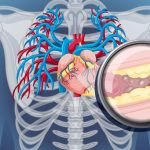By David Blyweiss, M.D.
There’s a lot of hype about statin drugs these days. The most recent is about their supposed ability to unclog your arteries and prevent heart attacks. And the two biggest proponents of this “benefit” are the pharmaceutical giants who make the prescription drugs Zetia and Vytorin. According to Merck and Schering-Plough, these two cholesterol-lowering drugs reduce both plaque and inflammation in the arteries. The problem is, it just isn’t true!
It turns out that these widely prescribed and expensive cholesterol drugs don’t do a darned thing to reduce the amount of plaque in your arteries. There’s also no concrete evidence that these and other cholesterol-lowering drugs prevent heart attacks, stroke and other cardiovascular problems. If that wasn’t enough, these cholesterol-lowering drugs come with a host of side effects, from muscle pain and weakness to memory loss to a potentially deadly condition called rhabdomyolysis that causes kidney failure. And the risk of side effects simply goes up when you take Zetia and Vytorin. Another study published last year showed a potential increase in cancer among patients taking these drugs compared with those taking only statins.
But here’s what I find so ironic. According to a recent study in the New England Journal of Medicine, niacin—a well-known and inexpensive B vitamin—can help unclog arteries in people already taking a statin drug like Lipitor. Better yet, combined with a heart healthy diet and exercise, niacin can significantly boost your HDL cholesterol levels, even if you aren’t taking a statin drug.
The study, which was conducted at Walter Reed Army Medical Center, followed about 200 patients who were already taking statins. Some were also given Niaspan, a modified form of niacin. The rest took Zetia. Researchers took images of the carotid artery—the artery leading to the brain—to measure the thickness of the artery walls over 14 months.
The patients who took Niaspan had less plaque in their arteries and also had higher levels of high-density lipoprotein or HDL. Known as “good” cholesterol, HDL removes cholesterol from the arteries and carries it back to the liver, where it is then eliminated from the body. But the patients who took Zetia had more plaque in their arteries, even though they had lower LDL levels. They also had more heart attacks, strokes and other cardiovascular problems than the patients taking niacin.
Vytorin and Zetia are among the most popular drugs that doctors prescribe. Last year, physicians in the U.S. wrote a total of more than 29 million prescriptions for them, and worldwide sales totaled $4.56 billion. So it isn’t surprising that top Merck executives are vigorously defending their drugs and have dismissed the new research as limited. But this isn’t the first study that shows that these drugs are worthless, and even potentially harmful.
Because of these new studies, many doctors are taking another look at niacin as a way to reduce arterial plaque and improve the ratio of good to bad cholesterol. In one landmark study of 136 people with high cholesterol, researchers randomly assigned the participants to receive either niacin or lovastatin. While both groups saw benefits, the statin was slightly more effective at lowering LDL cholesterol. But, when it came to HDL, those in the niacin group experienced a 33 percent increase compared to just seven percent for the statin group.
But as good as it is for tackling cholesterol itself, niacin is even better at lowering lipoprotein(a). Lp(a) are protein compounds that carry fats like cholesterol in the blood. While Lp(a) is a lot like LDL cholesterol, it plays an even greater role in creating the plaque that can narrow your arteries. And those with a family history of heart disease are at particularly risk for high levels of Lp(a). But one clinical trial found that niacin reduced Lp(a) levels by an impressive 35 percent. And other studies have shown that this nutrient can lower Lp(a) levels even more—up to 38 percent.
Because of these benefits, I strongly recommend niacin to my patients at risk of heart attack or stroke, as well as those who need to improve their cholesterol profile. But be aware that niacin comes in several forms—immediate release, slow-release, extended-release and non-flushing varieties. While most people prefer a non-flushing niacin supplement (the kind that prevents your skin from temporarily turning warm and red), it isn’t the most effective. Slow and extended-release supplements also carry other concerns—mainly liver toxicity. But immediate release niacin is both safe and effective when taken before bedtime. To reduce flushing, start with one dose of 250 mg. and increase the dose gradually to give your body a chance to adapt. You can also try taking it with a dose of stinging nettle—500 to 700 mg. should do the trick.
While niacin can be a safe way to reduce dangerous Lp(a) levels, it’s best to work with your doctor or naturopath to establish the correct dosage. It’s also good to have your doctor periodically check your liver function since high doses of any type of niacin can impact your liver.
References:
Gómez-Garre D. Ezetimibe reduces plaque inflammation in a rabbit model of atherosclerosis and inhibits monocyte migration in addition to its lipid-lowering effect. British Journal of Pharmacology. 2009;156: 1218-1227.
Pan J. Niacin treatment of the atherogenic lipid profile and Lp(a) in diabetes. Diabetes, Obesity & Metabolism. 2002;4:255-61.
Taylor AJ. Extended-Release Niacin or Ezetimibe and Carotid Intima-Media Thickness. New England Journal of Medicine. 2009;361:2113.


